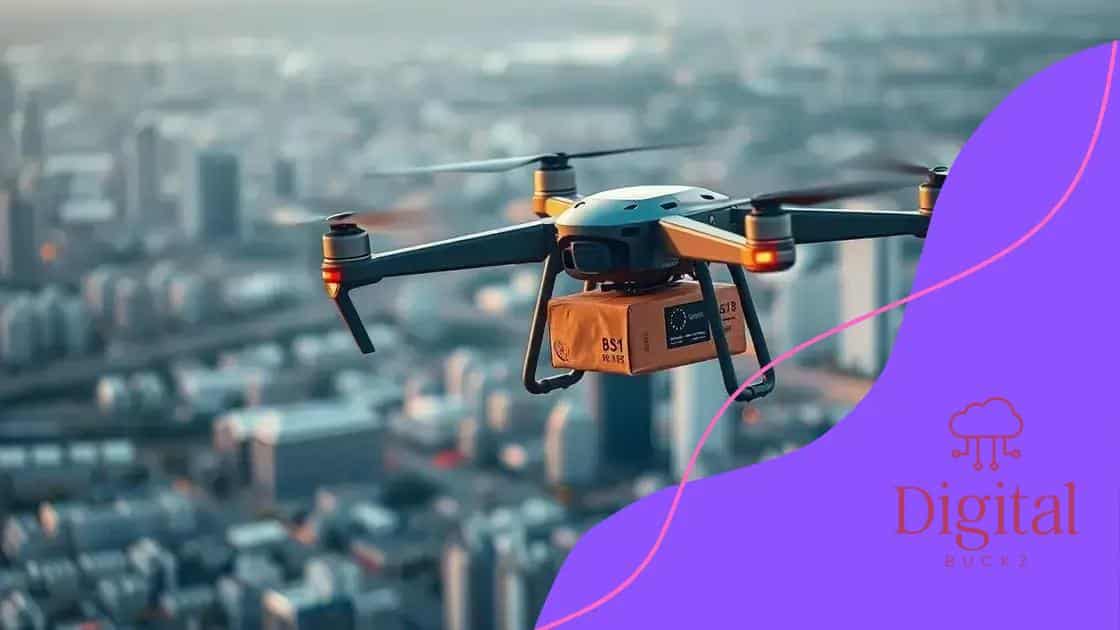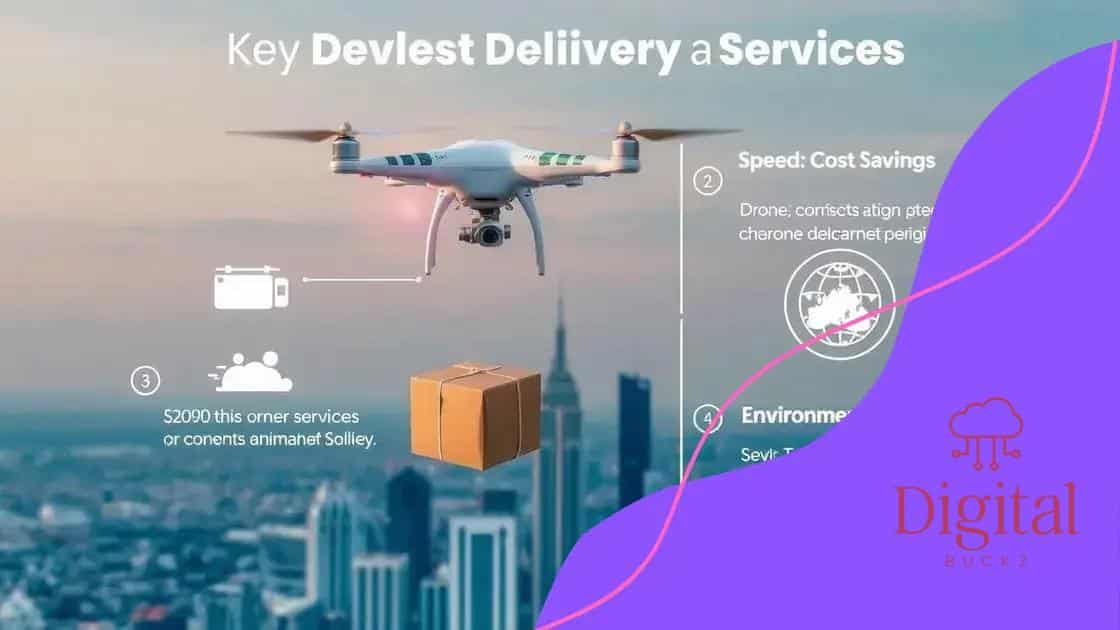The role of drones in delivery services worldwide

The role of drones in delivery services worldwide is revolutionizing logistics by providing faster, cost-effective, and environmentally friendly solutions, while also facing challenges like regulation and public perception.
The role of drones in delivery services worldwide is becoming increasingly significant. Imagine receiving your online order in a matter of minutes! This technology not only enhances delivery speed but also reshapes our expectations.
Understanding drone technology
To grasp how drones work, it’s essential to understand the fundamental components that make up these remarkable machines. Drones, also known as unmanned aerial vehicles (UAVs), operate through a combination of hardware and software.
The main components include:
Key Components of Drones
- Quadrant frame: The frame supports all other parts and determines the drone’s size and design.
- Propulsion system: This includes the motors and propellers that allow the drone to lift off and maneuver.
- Flight controller: This is the brain of the drone, guiding its movements and stability during flight.
- Battery: Drones usually operate on rechargeable batteries, providing the necessary power for flights.
Each component plays a vital role in ensuring the drone functions efficiently, allowing it to reach high altitudes while delivering goods. Understanding how these components work together makes it easier to appreciate the role of drones in delivery services worldwide.
How Drones Navigate
Drones utilize GPS technology to navigate. By receiving signals from satellites, they can determine their precise location and follow designated flight paths. Additionally, sensors help them avoid obstacles, ensuring safe deliveries. This complex interaction allows drones to function autonomously or under human control.
In real-time, data is sent back to the operator, enhancing their ability to monitor flights. The ability to remotely track a drone ensures that deliveries are made on time and without issues. As more people discover the benefits of drone delivery, the technology continues to evolve.
Current applications of drones in delivery
Currently, drones are making a significant impact on the delivery industry. Their ability to reach remote locations rapidly is changing how goods are distributed. The role of drones in delivery services worldwide is expanding as companies seek efficiency and speed.
Various industries are now embracing this technology, which allows for faster and often cheaper delivery options. Retail is one such sector. Many online retailers are experimenting with drone deliveries to enhance customer satisfaction.
Industries Using Drones for Delivery
- Healthcare: Drones are used to transport medical supplies, vaccines, and even organ transplants to hard-to-reach areas.
- Food Services: Restaurants and food delivery companies are piloting drone services to deliver meals quickly.
- E-commerce: Major online retailers are utilizing drones to ensure that packages arrive on time, often within hours of ordering.
- Logistics and Shipping: Companies are implementing drones to handle logistics, allowing for enhanced efficiency in shipping operations.
Each of these applications demonstrates how versatile drone technology can be. The speed at which drones can operate minimizes delays, ensuring that customers get their products when they need them. Businesses are seeing lower shipping costs and increased overall satisfaction due to this innovative approach.
Benefits of Using Drones
Cost-effectiveness is one of the standout advantages of using drones. They require less fuel and manpower compared to traditional delivery methods. This efficiency translates into lower prices for consumers and improved profit margins for businesses.
Moreover, the flexibility of drone delivery cannot be overlooked. Drones can bypass traffic and navigate through challenging terrains, making them the perfect solution for areas that are typically hard to service. The growing interest in drone technology suggests that its applications will only expand over time.
Key benefits of drone delivery services

Drone delivery services are quickly gaining popularity due to their numerous advantages. They offer unique solutions that traditional delivery methods often cannot match, making them a game-changer for businesses and consumers alike.
One major benefit of using drones is speed. With the ability to fly directly from the warehouse to the customer’s location, drones can significantly reduce delivery times. Customers no longer need to wait days for their packages to arrive. Instead, they can receive items almost instantly.
Cost Savings
Another significant advantage is the cost-effectiveness of drone deliveries. Drones require less energy than delivery trucks and eliminate the need for multiple drivers. This efficiency leads to reduced shipping costs for both retailers and consumers.
- Lower Fuel Costs: Drones consume less fuel compared to traditional vehicles.
- Reduced Labor Costs: Fewer drivers are needed, cutting down on labor expenses.
- Minimal Maintenance: Drones typically require less maintenance than trucks and vans.
This cost savings can be beneficial, especially for small businesses looking to improve their profit margins.
Environmental Impact
Additionally, drone delivery services are more environmentally friendly. They produce fewer greenhouse gas emissions than traditional delivery methods, contributing to a cleaner planet. This can resonate with eco-conscious consumers who prefer sustainable options.
Moreover, drones can navigate through traffic and difficult terrains, which boosts overall efficiency. They help eliminate road congestion by bypassing traditional routes, ensuring that deliveries are punctual.
These benefits exemplify how integrating drone technology into delivery services can transform the logistics landscape. As innovations continue to develop, we may see even more advantages unfold, making drone delivery a vital part of future commerce.
Challenges facing drone logistics
Despite the rapid growth of drone logistics, several challenges impede its full adoption. These challenges range from regulatory hurdles to technological limitations, impacting how drones fit into the delivery landscape.
One significant issue is regulation. Different countries have varying laws regarding drone operations, creating confusion for companies looking to expand their services. Regulatory bodies must create clear guidelines that ensure safety while promoting innovation. Without consistent regulations, companies often face delays when trying to obtain the necessary permissions.
Technological Limitations
Another challenge is the technology itself. While drones have come a long way, there are still limitations to their capabilities. Issues such as battery life and payload capacity can restrict the distance and weight of deliveries. Battery life often limits flights to short distances, meaning longer delivery routes may not be feasible.
- Battery Efficiency: Current batteries may not support longer flights needed for extensive delivery needs.
- Payload Restrictions: Most drones can only carry a limited weight, which restricts the types of packages they can deliver.
- Weather Conditions: Drones are affected by strong winds and rain, limiting their operational capabilities during bad weather.
In addition to these issues, public perception also plays a critical role in the growth of drone logistics. Some people may view drones as invasive or risky, raising concerns about privacy and safety. Addressing these concerns is essential for increasing acceptance and trust in drone delivery services.
As technology evolves, many companies are actively working to overcome these challenges. Collaborations between tech firms and regulatory agencies are essential for devising solutions that enable safe and effective drone operations. While obstacles remain, the potential benefits of drone logistics make addressing these challenges worthwhile.
Future trends in drone delivery systems
The future of drone delivery systems looks promising and exciting. As technology advances, we can expect to see innovative changes that will enhance efficiency and broaden the scope of what drones can deliver.
One significant trend is the improvement in battery technology. Longer-lasting batteries will enable drones to cover greater distances, making it possible for deliveries to reach rural or hard-to-access areas. Enhanced battery life could be the key to expanding the range of delivery services.
Increased Automation
Another trend is the rise of automation in drone operations. Many companies are starting to use automated systems for tracking deliveries and managing fleets. This increase in automation helps reduce human error and enhances reliability in logistics.
- Data Analytics: Companies will use data to optimize flight paths and delivery schedules.
- Autonomous Flight: Future drones may operate without human intervention, allowing for faster turnarounds.
- AI Integration: Artificial intelligence will play a role in decision-making, enabling drones to adapt to changing conditions.
Moreover, advancements in drone design will allow for more payload customization. This will help businesses cater to specific delivery needs, from food to medical supplies. As consumer demands evolve, adaptable delivery options will likely become essential.
Regulatory Changes
As drone usage increases, we should also see significant changes in regulations. Governments will likely create new policies that facilitate drone deliveries while ensuring safety and privacy. This shift will streamline operations and encourage broader adoption of drone technology.
The collaboration between tech companies and regulatory agencies will be crucial for shaping the future of delivery systems. By addressing security and operational challenges effectively, the potential for drone delivery services is vast and within reach. Overall, drone delivery systems are on the cusp of transformation, poised to revolutionize how goods are transported worldwide.
FAQ – Frequently Asked Questions about Drone Delivery Systems
What are the main advantages of using drones for delivery?
Drones offer faster delivery times, cost savings, and lower emissions compared to traditional delivery methods, making them an attractive option.
How do drones navigate to their delivery destinations?
Drones use GPS for navigation, allowing them to follow predetermined flight paths while avoiding obstacles.
What challenges do drone delivery services face?
Challenges include regulatory hurdles, technological limitations like battery life, and public perception regarding safety and privacy.
What future trends should we expect in drone delivery systems?
Future trends include improved battery technology, increased automation, greater payload capacity, and evolving regulations to support drone operations.






